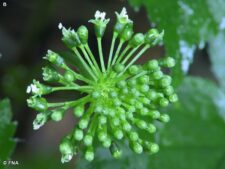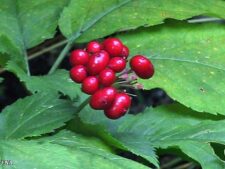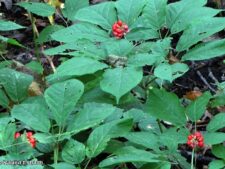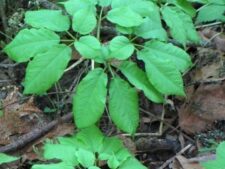
GINSENG
Panax quinquefolius
GINSENG FAMILY (Araliaceae)
 Identification
Identification
- Flowering time - June, July
- Rare in woodlands at FF and NW
- Whorls of oblong leaflets with pointed tips
- Single round cluster of greenish-white flowers on a long stalk
- Bright red, oblong berries
This native perennial grows up to 2 feet tall with 3-4 large leaves, each with 5 pointed, oblong leaflets (A). The small greenish-white flowers are fragrant and arranged in a cluster (umbel) on a long stalk rising from between the leaves (A,B). The fruit is a cluster of bright red oblong berries (drupes)(C).
Rare and endangered at both sites; the flowers bloom in June and July. The known locations are not provided here to protect the few remaining plants and their highly sought-after roots.
Ginseng roots have been a staple of traditional Asian medicine for as long as 5000 years.
As Asian supplies became scarcer and the value increased, early American settlers quickly responded by harvesting thousands of tons of the roots for export. Since taking the roots killed the plant, overharvesting of this “green gold” soon depleted populations and it is now uncommon over much of its former range. Harvesting and export today is quite closely regulated and most of the ginseng marketed is produced on commercial farms.
Also known by its other common name, American Ginseng
The content of NatureSearch is provided by dedicated volunteer Naturalists of Fontenelle Forest who strive to provide the most accurate information available. Contributors of the images retain their copyrights. The point of contact for this page is: Roland Barth.




